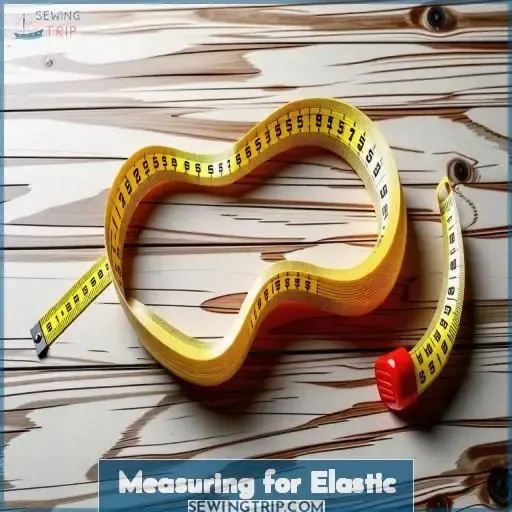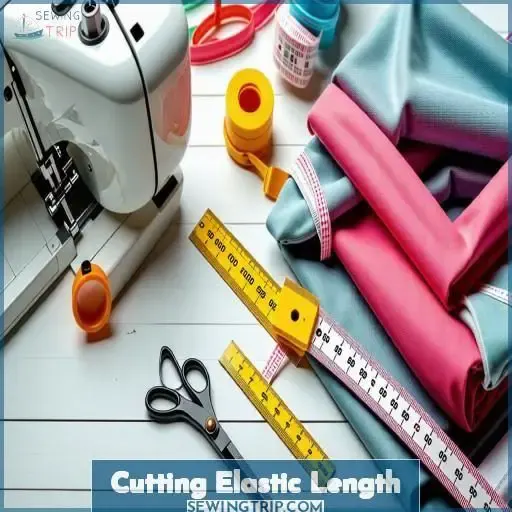This site is supported by our readers. We may earn a commission, at no cost to you, if you purchase through links.
 Mastering the art of sewing with elastic is a must for any sewing enthusiast tackling stretchy projects.
Mastering the art of sewing with elastic is a must for any sewing enthusiast tackling stretchy projects.
You’ll want to start by properly measuring and cutting your elastic to guarantee a seamless fit.
Our tutorials on sewing elastic will guide you through attaching it directly to the fabric using a zigzag stitch, as well as creating casings for a clean finish.
We’ll cover overlapping ends, distributing gathers evenly, and topstitching waistbands like a pro.
Table Of Contents
Key Takeaways
- Properly measure and cut elastic to ensure a seamless fit, considering fabric type, elastic stretch, and desired tension
- Attach elastic directly to fabric using a zigzag stitch, evenly distributing gathers and maintaining even tension
- Create clean, professional-looking casings by determining the right width, folding fabric inwards, and inserting elastic smoothly
- Finish elastic waistbands with fold-down casings or applied waistbands, and achieve a polished look by evenly distributing gathers and topstitching with a straight stitch
Measuring for Elastic
To sew elastic successfully, you first need to determine the right type and placement. Consider the fabric you’re using – lightweight elastic works best with delicate fabrics, while sturdy elastic is ideal for heavier materials. Adjust your sewing machine tension** to accommodate the elastic’s stretch.
Next, decide where you want the elastic to sit. For a waistband, measure around your natural waist. Pin the elastic in place, making sure it’s smooth and even. Use a zigzag stitch to attach the elastic to the fabric, securing it at the seam allowance. Finish the seam with a serger or zigzag stitch to prevent fraying.
With the right elastic and placement, you’ll achieve a comfortable, professional-looking result every time. Stay tuned for the next step – cutting the elastic to the perfect length!
Cutting Elastic Length
When cutting elastic for sewing projects, you’ll need to allow an extra inch or two of overlap at the ends to guarantee a secure closure. Additionally, account for the fabric’s stretch by cutting the elastic slightly shorter than your measured length to achieve a snug yet comfortable fit.
Allowing for Overlap
When cutting elastic for a waistband, overlap the ends by 1-2 inches to reinforce the join. This extra length allows the elastic to stretch comfortably around your waist without breaking the stitches. Secure the overlapped ends with a zigzag stitch for maximum flexibility and durability. The casing will conceal the raw edges for a polished look.
Adjusting for Stretch
When cutting elastic length, consider the fabric’s stretch percentage for the perfect fit.
Elastic types vary in tension and stretch, affecting garment construction.
Always test the fabric’s recovery post-stretch to guarantee durability.
Adjust the elastic length based on the desired tension and body measurements.
Use proper sewing techniques and secure the elastic firmly at anchor points to maintain the stretch efficiently.
Attaching Elastic Directly
To attach elastic directly to fabric, you’ll first want to pin the elastic in quarters around the fabric edge, ensuring it’s evenly distributed. Then, use a zigzag stitch to sew the elastic in place, allowing the stitch width to stretch over the elastic for a secure, stretchy attachment.
Pinning in Quarters
To evenly distribute the elastic tension, pin the elastic to the fabric in four equidistant points. Align the pins with the side seams and center front and back. This quartering technique guarantees the elastic is securely attached without puckering or twisting. Use sharp pins and a firm grip to maintain the elastic’s stretch as you sew.
Zigzag Stitch Technique
To sew elastic directly onto fabric, use a zigzag stitch for stretch and durability.
Adjust your machine’s stitch length and width for uniform stitches.
Experiment with thread tension and needle size to prevent skipped stitches or fabric puckering.
Make sure your presser foot applies even pressure as you guide the elastic under the needle.
For a professional finish, consider using a serger or overlocker machine, especially on lightweight fabrics like linen.
Creating an Elastic Casing
To create an elastic casing, you’ll first need to determine the proper width by adding the elastic width plus around 1/4 inch for ease. Then, fold the fabric inwards along this measurement to create a tunnel, pinning or basting the folded edges in place before stitching down each side to form the casing.
Determining Casing Width
To determine the casing width, measure the elastic width and add 1/4 inch for ease allowance and seam allowance. Consider the fabric thickness as well. The casing width will vary depending on the waistband style, but this formula provides a good starting point. Adjust as needed for a comfortable, well-fitting waistband.
Folding Fabric Inwards
To create the casing, fold the fabric inwards twice, with the first fold about 1/4 inch deep and the second fold the width of your elastic plus 1/4 inch for ease. Pin the folded fabric in place, leaving a gap for inserting the elastic later. Sew a straight stitch 1/4 inch from the fabric edges to secure the casing.
Inserting Elastic in Casing
To insert the elastic into the casing, attach a safety pin to one end of the elastic and use it to guide the elastic through the fabric tunnel. This will help prevent the elastic from twisting or bunching as you feed it through the casing.
Using a Safety Pin
To insert the elastic into the casing, attach a safety pin to one end and gently push it through the opening. As you feed the elastic through, keep it flat and untwisted. When the pin emerges at the other end, remove it and overlap the elastic ends by 1 inch. Secure them with a zigzag stitch for a durable waistband.
Avoiding Twists
To avoid twists when inserting elastic into a casing, manage elastic tension carefully to prevent overstretching or bunching. Consider the stretch factor of the elastic against the fabric choice, especially with slippery fabrics. Place pins strategically along the casing to secure the elastic, ensuring it stays aligned. Hand-sewing can provide more control over the process, allowing you to adjust and guide the elastic smoothly.
- Manage elastic tension effectively
- Consider fabric stretch factor
- Strategically place pins along the casing
Joining Elastic Ends
You’ll need to overlap the two ends of the elastic when joining them together. Use a zigzag stitch to reinforce the overlapped area, ensuring the elastic is secure and won’t come apart during wear.
Overlapping Method
To join elastic ends, simply overlap them by 1-2 inches and secure with a zigzag stitch. This overlap technique provides the necessary stretch allowance and reinforces the joint for added security. The zigzag stitch is ideal as it stretches with the elastic while locking the threads in place. Backstitch at the beginning and end for extra durability.
Zigzag Stitch Reinforcement
To reinforce elastic ends, overlap them by 1 inch and sew with a zigzag stitch.
Adjust your machine’s stitch length and width for the fabric’s elasticity.
Use a sharp needle to pierce the elastic without skipping stitches.
Maintain even tension to prevent puckering.
For extra durability, sew a box or X over the overlap.
Experiment with alternatives like bartacks or triple zigzag stitches.
Finishing Elastic Waistbands
There are two main approaches for finishing elastic waistbands: fold-down casings and applied waistbands. Fold-down casings involve creating a fabric tunnel by folding over the waistline edge, while applied waistbands are separate pieces of fabric sewn onto the garment, encasing the elastic.
Fold-Down Casings
To achieve a professional finish with fold-down casings for elastic waistbands, start by selecting a suitable fabric. Consider ease allowance and pattern variations for a customized look. Sewing techniques such as folding fabric inward and stitching it securely guarantee a neat finish. Explore different finishing options such as basic, tiered, or paperbag waistbands for added variety and style.
Applied Waistbands
When finishing elastic waistbands using applied techniques, consider various elastic textures and fabric choices to achieve different effects. Explore waistband variations and casing extensions to customize the look. Additionally, master topstitching techniques to enhance the durability and professionalism of the finished product. This attention to detail in the application of elastic will elevate the overall quality of your sewing projects. (Source)
Topstitching Elastic Waistbands
To achieve a polished, professional look on your elastic waistbands, you’ll want to distribute the gathers evenly before topstitching. Use a straight stitch, keeping the fabric and elastic flat as you sew, allowing the elastic to ease in and out naturally with each line of stitching.
Distributing Gathers Evenly
To distribute gathers evenly, stretch the waistband and fabric flat as you sew.
Pin the waistband in place, adjusting fabric tension as needed.
Use a stitch length of 2.5-3mm for best results.
Make sure your presser foot pressure is light to prevent puckering.
Maintain a consistent 5/8 seam allowance for a professional finish.
Smooth fabric gently as you sew to create uniform gathers.
Straight Stitch Technique
With your elastic waistband evenly distributed, it’s time to topstitch using a straight stitch. Adjust your machine’s tension and thread type for a smooth finish. Choose a needle size that penetrates without skipping stitches. Stabilize lightweight fabrics to prevent puckering. Reinforce the topstitching at stress points for added durability. Take your time and enjoy the satisfying results!
Frequently Asked Questions (FAQs)
What is the best stitch for sewing elastic?
You’ll want to use a zigzag stitch when sewing elastic. The zigzag allows the elastic to stretch while keeping the stitches secure.
How do you sew elastic directly to fabric?
To sew elastic directly onto fabric, first pin it at quarter intervals. Then, zigzag stitch over the elastic, allowing it to stretch as you sew. Apply even tension to keep the elastic flat against the fabric.
How to insert elastic into a waistband?
Inserting elastic is like lassoing a wild stallion – thrilling yet tricky! Measure your waist snugly, attach a safety pin to one end, then carefully feed the elastic through the casing. Overlap the ends, sew in place, and voilà – a perfectly tamed waistband awaits!
Do you stretch elastic before sewing?
Yes, you’ll want to stretch the elastic while sewing to maintain proper tension and fit. Slightly stretch and distribute the elastic evenly as you sew it in place.
How to troubleshoot twisted elastic insertion?
Avoid twisting by cutting elastic longer, using safety pin guidance. If twisted, gently untwist elastic while feeding through casing. Take time to smooth for even distribution.
Can different topstitching variations be customized?
It’s all about getting creative – play with stitch length, spacing, and stitching direction to customize your topstitching. A diamond pattern or contrasting thread adds a unique touch. The possibilities are endless when you experiment!
Ways to ensure elastic durability and professionalism?
For durable and professional elastic, topstitch with heavy-duty thread using a triple stitch or cover stitch. Choose firm, quality elastics, and overlap ends generously when joining. Precise, even stitching and quality finishing guarantee a polished, long-lasting result.
What are the variations of topstitched waistbands?
Fun fact: 93% of sewists prefer topstitched elastic waistbands! You can create a sleek, polished look with the Donovan Skirt’s drawstring option. Or embrace athleisure with jogger-style cuffs like the Arden Pants. Customizing stitch lines adds your personal flair!
Tips for handling wider elastic in sewing?
When using wider elastic, increase the number of topstitching lines to evenly distribute the tension. A walking foot prevents fabric stretching during stitching. Test scrap fabric for best stitch length and tension settings before sewing on your project.
Conclusion
Mastering the flexible world through our tutorials sewing elastic opens up boundless opportunities. With each stitch, you’ll gain confidence in crafting garments that move effortlessly with your body. Embrace the techniques, from measuring precisely to topstitching waistbands with flair, and watch as your creations come alive, hugging every curve to perfection.













